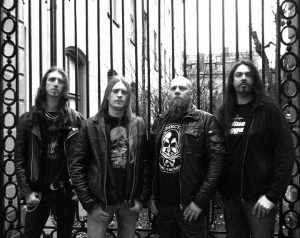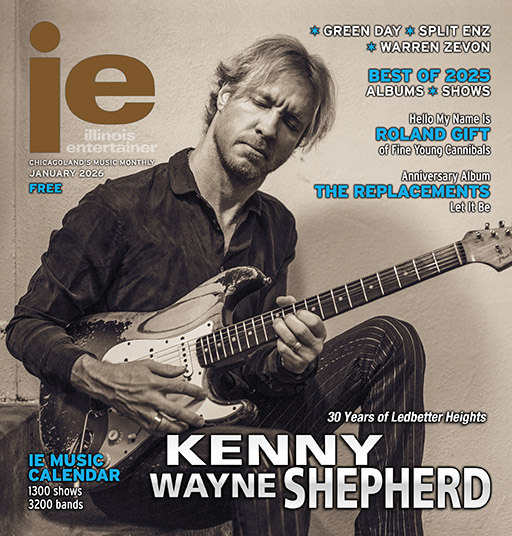Caught In A Mosh: September 2012
We’ve been on that path for many years,” says a voice seven hours in the future. In Sweden, it is already dark. Ola Lindgren, vocalist/guitarist of Grave, assumes nothing while fielding foreign questions in preparation of Grave’s North American tour with Morbid Angel and Dark Funeral. He is referring to the no-frills gravel road his band has taken since its official formation in 1988. “Very brutal, straightforward, heavy death metal,” continues the sole founding member. “We never set out to be technical or complicated in any way.” He should need no introduction.
Without Grave, Chicago doom metal might never have incorporated harsh vocals. Paul Kuhr, singer of the cataclysmic Novembers Doom, which formed in 1989, went so far as to put the Swedish act on par with revered cult demo bands Devastation and Sindrome. “The concept of the band in the beginning was to be as heavy and guttural as the band Grave,” he said in a 2007 IE interview, “only played very slow.”
Lindgren recorded, mixed, and mastered Grave’s 10th studio album, Endless Procession Of Souls (Century Media), at a studio the four-piece built itself this year (Studio Soulless). The result is a classic Swedish death-metal otherworld, where ghosts leave staggered footprints (“Disembodied Steps”) and crusty two-beats support death-reveling grunts (“Passion Of The Weak”). Adds the anachronistic engineer, “It’s pretty cool to release an album that sounds like it could have been our second or third.” Grave plays in the present on Oct. 4 at Mojoes.
Mosh: Where in Sweden are you now?
Ola Lindgren: Stockholm. We’re all here now. We’re pretty much from all over the country, but everybody lives here to make it easy. The band started on an island called Gotland, which is in the Baltic Sea, about five hours by ferry [from the Swedish mainland] in the middle of nowhere, really. That’s where [the founding lineup] grew up. We started playing together in seventh-grade or so. Gotland is a huge tourist thing in the summertime, but after mid-August, it just shuts down and becomes a ghost town for eight months until the next summer. We didn’t have anything to do down there. The only thing we did after school was go straight to the rehearsal place.
M: It’s my understanding the government of Sweden heavily encourages Swedish youth to make music. Until a certain age it will pay for your instruments and recording sessions, even pay you to make music?
OL: Yeah. It’s called like a community music school [and] the rehearsal place we had was under something like that. We didn’t pay rent for it. We could just be there and work on the music . . . all the way from early Corpse [one of the names the band used before becoming Grave] in ’85, ’86, until we moved to Stockholm in ’91. It was a good thing . . . to keep kids from roaming the streets.
M: The book Swedish Death Metal by Daniel Ekeroth suggests a 1992 Deicide show in Stockholm was a turning point for Swedish death metal. The venue was bombed. The show was shut down. People said they felt ripped off. Ekeroth calls it “the Altamont of Swedish death metal.” Norwegian black metal temporarily became the favored extreme music. Tell us about those times.
OL: It wasn’t really that early. At least not for us. We did a lot of stuff in those years. We put out the first album in ’91. I was 20 at the time. We did two more tours in the three coming years, so it was a very active period for us and I think also for Entombed and Unleashed . . . I’d say [it was] ’95, ’96 when it very much turned toward black metal, and the interest slowly faded out for death metal. There weren’t many [death-metal] bands that were active in those late ’90s years. We didn’t do anything from ’96 until 2000, pretty much because of lack of interest from both label and fans. We couldn’t put on a show at all. People didn’t have any trust that people would show up. But, everything goes in cycles and it came back pretty strong.
M: In the documentary 666 At Calling Death, former Grave member Jorgen Sandstrom said of Norwegian black metal: “They want to kill everyone in the death-metal scene in Sweden . . . but you can’t take that too serious, either. Why should I be afraid of someone that lives 200 miles away from me?” Was Grave one of the bands that received death threats from Norway?
OL: I don’t think any of us personally in Grave, but I heard a lot of stuff. Entombed, for instance. The guys in Therion had some incidents. It was just a lot of talk, really. I remember we played in Oslo [Norway] with Dismember and Morbid Angel in ’93. The Morbid guys were kind of freaked out. Like, “Oh, what the fuck is going to happen now when we go over there?” They heard the rumors as well. They thought it was going to be a big riot and that the “raccoons” were going to come there and try to kill us off.
M: The Alice In Chains cover tune on 2006’s As Rapture Comes seemed an unlikely choice for a Swedish death-metal band, but “Them Bones” became my favorite song in your discography. It’s so incredibly heavy and unique while honoring the original, particularly the guitar solos and the grunge-rock tempo. What made you choose that song to cover?
OL: I had the idea for some years before we actually recorded it. I’ve always loved that band and everything they’ve ever done, and I think they stood out a little bit from what you would call the grunge scene. I was never into Nirvana or Soundgarden or anything like that. But, I always thought that Alice In Chains had [a] different twist to it, and we messed around with it during the recordings. We said, “We’ll see when we get the vocals on there if it’ll turn out good enough [to] release.” I think it came out pretty killer in the end. It is a very unlikely choice, definitely.
STILL DON’T WANT TO DIE: Headbangers love to hate on press-release hub Blabbermouth.net and its neuro-diverse cast of commenters (especially that mouthbreather RiotAct666! What a tool!), but the flame-baiting website is where we all end up when we’re drunk and alone. I mean, when we get the rare urge to catch up with the fallen angels and the pop-metal diversions of our childhood, including Evanescence. Thanks to “the CNN of heavy metal and hard rock news,” we know that Chicago doom-metal band Trouble is recording an album with its third frontman in four years (Kyle Thomas, singer at four Trouble shows in the late 1990s). And we know that Northwest suburban Witchslayer has reformed. Wait, WITCHSLAYER? OMG!
“The original band that did the demo,” confirms vocalist Jeff Allen from Tampa, his and drummer Dale Clark‘s current hometown. Allen and guitarist Craig McMahon were key in bringing early ’80s Chicago metal to the attention of those outside Illinois via Metal Blade, the label known in the era for breaking Metallica (“Hit The Lights” on 1982’s Metal Massacre compilation). In May 1983, the two longhairs from Forest View High School in Arlington Heights trekked to San Bernardino, California, to see the sophomore Us Festival (The Clash, Van Halen, U2). While in the state they set off to ambush Metal Blade owner Brian Slagel with the five-song demo their power/doom-metal four-piece had recorded that year in Lake Villa. Members of Illinois-forged metal bands Thrust and War Cry tagged along.
“He’s in this little, shitty office facility, and we just walk in there. We’re all rocked out . . . and we’re like, ‘Hey, dude, we heard you’re talking about putting together another Metal Massacre.'” Tapes were traded. A concept emerged. “Slagel was like: ‘Screw it, I’ll just do a Chicago metal album. Get as many bands from Chicago and we’ll put ’em all on the same album.'” Of the 12 acts on that winter’s Metal Massacre 4, five had Illinois roots: Witchslayer, Trouble, Zoetrope, War Cry, and Thrust. Trouble’s public recording debut, “The Last Judgement,” foreshadowed a famed first LP on Metal Blade (and infamous “white metal” marketing push). War Cry’s “Forbidden Evil” introduced a young Paul Speckmann (Master) on bass. (Master’s 11th full-length, The New Elite, is out now on Pulverised.) Witchslayer’s atmospheric ripper “I Don’t Want To Die” is the group’s only pressed song to date.
The singer cites the loss of bassist Sean McAllister to Trouble and an aborted shot at opening for Accept as impetuses for the band’s 1984 breakup. After McAllister (now in McHenry) announced his departure in the early ’80s, Allen kept him aboard long enough to play bass on the demo (and subsequently the demo-sourced Metal Massacre 4, despite liner notes naming his replacement). Thirty years ago Witchslayer had at least 10 songs written for a full-length. “We wanted to make like a horror movie. Just . . . creepy-ass music,” Allen says, explaining with a laugh that McMahon is now a horror filmmaker in Phoenix.
The songs don’t want to die: “We’re planning on rehearsing remotely and then getting together and recording the darned thing and mixing it. We’d like to get it done this fall. You know how these things are. You put a goal out there and you just work toward that.”
MOSH-WORTHY . . . LIVE: Yob (Beat Kitchen, 9/12); Kreator (Mojoes, 9/15); Obituary, Broken Hope (Reggies, 9/17); Down (House Of Blues, 9/22); Saint Vitus (Bottom Lounge, 9/30).
MOSH-WORTHY: Bullet Full Pull (Nuclear Blast); Poison Idea The Fatal Erection Years (Southern Lord); Fastkill Bestial Thrashing Bulldozer (Pulverised); Admiral Sir Cloudesley Shovell Don’t Hear It . . . Fear It! (Metal Blade/Rise Above); Dicks Kill From The Heart reissue (Alternative Tentacles).
— Mike Meyer
Category: Caught In A Mosh, Columns, Monthly












